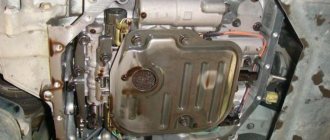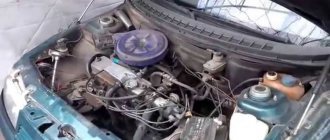02/28/2022 10,420 Transmission
Author: Victor
An automatic transmission is a more advanced and modernized option compared to a manual transmission. This type of gearbox is characterized by a rather complex design. Malfunctions that may arise in its operation will be more difficult to diagnose, unlike mechanical units. For what reasons does the automatic transmission kick in and how can a car owner solve this problem, you will learn from this article.
[Hide]
Does it kick when it's cold or hot?
It happens that the automatic transmission kicks and jerks at all speeds or when shifting from 1 to 2. You need to figure out whether it kicks when it's hot or when it's cold.
Causes
It does not matter whether this problem occurs when starting off or when driving at low speeds. The reasons for this behavior of the unit are usually the following:
- There is a lack of transmission oil in the system.
- The substance used for lubrication has lost its technical properties and has become of low quality.
- Problems have appeared in the operation of the main unit of the unit - the torque converter. In particular, we are talking about difficulties in the functioning of the blocking device.
Remedy
Problems of this kind can be eliminated in several ways:
- Add lubricant to the transmission system. You need to find the inspection and filler holes on the gearbox, fill in the fluid so that it meets the standard. It is advisable not to overfill it.
- If the problem lies in quality, the lubricant must be replaced. When draining, pay attention to the condition of the substance. If there are traces of deposits and dirt in it, then it makes sense to wash the box. Otherwise, the unclean oil that remains in it will mix with the new one. Accordingly, fresh lubricant will also lose its properties in the near future.
- Problems with the operation of the blocking device are resolved by computer checking the unit.
The video below will allow you to learn more about the torque converter lock-up device, as well as malfunctions that can occur in its operation. The material was filmed and published by Dmitry Yakovlev.
Why does the automatic transmission shift jerkily?
To get rid of a problem, you need to understand the cause of its occurrence. Let's briefly consider the principle of operation of an automatic transmission; this is the only way to understand where the jerks come from when switching an automatic transmission. Without going into technical details, gear shifting in an automatic transmission occurs hydromechanically. From the engine, torque is transmitted to the gearbox shaft through a fluid coupling. Instead of rigidly coupled gears, two impellers are used: a driving one (fixed to the engine shaft) and a driven one (fixed to the “automatic machine” shaft).
Torque transmission occurs through ATF fluid. The driving impeller (pump) creates a flow of liquid working medium, which spins the driven element (turbine). Such a design should eliminate box kicks and, in general, any harshness of the transmission - the fluid smoothes out all mechanical movements.
To change the gear ratio in the automatic transmission, certain discs with friction-coated surfaces are sequentially blocked. To perform these actions, the ECU issues commands to the valve system. Transmission fluid, flowing from one cavity to another, activating the pistons, presses certain pairs of disks and unlocks others.
Thanks to this design, the transmission operates in automatic mode. The driver does not need to constantly depress the clutch and gas, or switch the lever, as with a manual transmission. The car is easier to drive. Why do jerks and kicks occur in the automatic transmission? There are different reasons. We'll figure it out together.
Can't you spoil the porridge with oil?
This saying is true only for fresh produce and within reasonable limits. If you add rancid or sour oil to porridge, nothing good will come of it. Also, few people will like it if there is more butter than cereal. With the gearbox everything is exactly the same. An automatic transmission must contain technical fluid suitable in terms of parameters, and its volume must be optimal - not too much and not too little.
Working fluid aging
During operation, ATF heats up, its chemical composition gradually changes, and with it the viscosity indicators. If you do not monitor the condition of the fluid, jerking of the automatic transmission will definitely appear - it’s a matter of time. Transmission oil with non-standard properties will not be able to transmit torque correctly.
Synthetic gear oil
Synthetic gear oil with viscosity class 75W-90. Buy oil for manual transmission gearbox with a manufacturer's warranty.
more reviews
Considering the operating conditions of cars in our country, it is recommended to change the ATF every 30-40 thousand kilometers. If the automatic transmission starts jerking before this figure, check the fluid. A strong change in color, foreign inclusions, or an unusual smell is a signal that the oil in the automatic machine needs to be changed.
Along with replacing the ATF, it is necessary to clean or change the oil filter. You may need to clean the throttle body and install new gaskets to replace those that are in question. It’s better not to be lazy and skimpy, otherwise you’ll have to change the fluid again.
To increase the resistance of ATF to adverse influences, we suggest using the tribotechnical composition “Automatic” from Suprotec. The product does not affect the composition of the oil, but improves the kinematics of all moving parts of the box and reduces friction. This allows you to reduce the heating of the fluid and reduce the formation of wear products. As a result, ATF maintains optimal performance longer - kicks do not occur in the gearbox .
Insufficient or excessive volume
If the automatic transmission shifts jerkily , the first thing you should do is check the amount of working fluid. The standard automatic transmission oil dipstick has minimum and maximum ATF level marks. If the check reveals an excess or lack of oil, you need to urgently correct the situation. Attention! You can only add fluids recommended by the manufacturer. If you pour a more advanced and modern product into the box, it will “kill” the unit as surely as adding low-quality oil.
The box jerks when accelerating
Sometimes it happens that the automatic transmission kicks when it’s hot and jerks while accelerating the car. Below we will look at why this happens.
Causes
What causes the car to jerk when accelerating:
- Some components of the transmission unit have worn out.
- The automatic transmission often kicks into gear as a result of violation of operating rules. Therefore, before using your car with an automatic transmission, it is recommended to carefully study the service manual for the car.
- Twitching may occur due to a violation of the timing or quality of maintenance of the unit.
- Making mistakes when changing the oil in the gearbox.
Remedy
To get rid of the twitching problem, do the following:
- Diagnose the quantity and condition of the lubricating fluid. If necessary, replace it and flush the transmission. The level must be normal.
- Carry out a detailed inspection of the condition of the unit. It is not recommended to disassemble the automatic transmission yourself, especially if you do not have experience in this. You can go to a service station or do a computer check. To do this, you will need a PC, software and a diagnostic adapter. The scanner is connected to the computer and a special connector, after which the program is launched. This method will allow you to identify fault codes that will indicate problems with the transmission.
- Be sure to familiarize yourself with the operating features of the gearbox. Study the service book and take into account all the nuances described in it.
You can learn more about diagnosing the fluid level and adding oil to the automatic transmission from the video (material published by the Live Video Blog channel).
After Changing the Oil, the Automatic Transmission Started to Kick ~ AUTOVIBER.RU
Automatic transmission kicks : what to do, reasons
The automatic transmission is very convenient. You can almost forget about the gear selector knob. But automatic transmissions are much more expensive to repair, and as for reliability, a lot depends on the make of the car and the type of gearbox. The driver’s attitude, driving style and service also play a significant role. Let's talk about why the automatic transmission kicks, what to do in this case and how to fix the problem.
Some general information
There are a huge number of reasons why an automatic transmission starts to kick . For many, this immediately causes panic. But it’s better to calm down, since often the problem is solvable and does not require intervention in the automatic transmission. I would like to immediately note that an automatic machine is, of course, convenient, but it needs to be monitored more carefully. Report “automatic transmission oil change 3.0 tdi casa” transmission. After changing the oil, the transmission began to twitch after repairing the automatic transmission and changing the oil. The lack of factory recommendations regarding the timing (and indeed the need) for changing the oil in the box is only one of the reasons for quitting. In 70% of cases, kicks appear precisely because of untimely maintenance of the node.
Some people think it’s completely unnecessary to change the oil and filters in an automatic transmission, and if kicks occur when switching to an upshift or downshift, they immediately blame the manufacturer for the fact that the gearbox is of poor quality, breaks, does not work well, etc. But if you follow the regulatory deadlines for maintenance, then the automatic transmission usually works for quite a long time, depending on the make of the car, from 100 to 300 thousand kilometers without major repairs.
The automatic transmission kicks: what to do?
The first thing you should pay attention to is the oil level in the automatic transmission and its condition. As noted above, many do not consider it necessary to change the ATF, but this is not true. All manufacturers recommend performing a complete replacement every 100-150 thousand kilometers, and a partial replacement every 60-80 thousand.
Another reason is that the wrong oil was filled in.
Many manufacturers indicate the required ATP in the operating instructions. Drivers do not always follow these recommendations and pour what they consider necessary. The result is kicking, jerking, unstable operation or untimely gear shifting. U341 automatic transmission began to kick after replacing the clutch. General questions about automatic transmission, transfer case, cardan, drive shafts, gearbox, viscous coupling, etc. If you continue driving like this, you may end up with a major overhaul. In any case, the reason must be found as quickly as possible if you notice that the automatic transmission is kicking. What to do in this case? First of all, check the automatic transmission oil . This is often done with the car running and warm. Much can be understood by the color of ATP. Detailed process of changing the oil in automatic transmission and manual transmission on Renault Megane 2, photo report, video content, advice from meganovodov. Darkening or lightening indicates that it is time to replace it.
How to properly change the oil in an automatic transmission?
If the transmission shifts jerkily and with shock, the reason may lie in the lubricant itself. How to change and add new fluid:
- Warm up the engine to operating temperature and allow it to cool for about 10 minutes.
- Climb under the bottom of the car and find the drain plug on the gearbox. This hole can be protected by a tray. Place an old container under it to collect waste fluid. Unscrew the bolts on the crankcase or the drain plug.
- Remove the filler or inspection hole cap.
- Wait until all the lubricant has left the system. This will take some time.
- Once the fluid is drained, clean the area around the hole. Also clean the plug itself and assess the condition of the seal on it. If it has fallen apart or is very worn, it must be replaced.
- Replace the cover along with the drip tray (if present). Tighten all bolts.
- Using a construction or medical syringe with a hose, fill the system with the required volume of liquid. It will depend on the specific vehicle. Before replacing, read the service book about exactly how much lubricant is needed. If there is no filler hole, use the inspection hole. Add the substance until it starts to come out.
- Screw the plug into place and start the engine. Perform a test drive and evaluate the quality of the transmission. At first, kicks may be observed when downshifting or upshifting. But with time it will pass. After this, check the box for leaks. If there are traces of oil leakage from the system, this problem needs to be solved.
1. Remove the automatic transmission pan, unscrew the drain plug and drain the fluid from the system
2. Screw the plug into place and fill in new lubricant through a funnel or syringe with a hose.
Why did the jerking appear after the replacement?
If the problem recurs after changing the lubricant, it is usually due to the use of the wrong fluid. It does not fit the vehicle. Or you didn't put enough into the system.
Remedy
To solve the problem, you first need to make sure the quality of the oil. In the service book for the car, read what standard of lubricant must be poured into certain boxes. Buy the appropriate fluid and add it to the transmission. You can replace it either yourself or at a service station. If the level of the substance is insufficient, then it is necessary to add it to the system.
The automatic transmission jerks and slips after an oil change | Page 3
a thousand kilometers ago I changed the oil with a partial change, filled in Aisin oil, bought two 4 liters each, after the change there was half a liter left. After that I didn’t like the performance of the gearbox (the shifting became softer, but some kind of slipping appeared, it was necessary to turn the engine longer and at higher speeds for shifting gears, especially noticeable when accelerating uphill to third) I came to the conclusion that this is due to the synthetic floor, here one friend on the forum wrote that each gearbox is configured for a specific oil, so if mineral water was filled there is nothing to pour in there, just anything if there are brains or they need to be sewn to fit what you want to fill, I won’t argue with that, I think he’s right. I bought ten liters of mobile phone, maybe a Toyota T4, it’s the same thing, made by the same manufacturer at different factories! I recently loaded up my mobile phone and it works more accurately. Replacement process: Drain the oil, remove the pan, remove the filter (you can wash it, it’s optional; there’s nothing special there, just a mesh that was clean), pulled out two tubes from the box that go to the radiator (there you need to unscrew the two bolts that hold them ) drain the oil from them, I took the tube and put it on one and blew out the remaining oil from them. Then we install the filter, pan, fill the oil until it flows out, take a tube of a suitable diameter to insert into the hole where the tubes going to the radiator were inserted (I had a little smaller one, I wrapped up a little electrical tape so that it fits tightly in the hole, the pressure there is normal, if it will not be tight, everything will be in the oil, you need to insert it closer to the front) the second end into the five from under the water, in it, you can clearly see when clean oil comes out and you also need one person to start the car. The one who holds the tube under the car and watches when clean oil comes out. The first time we start it, after a couple of seconds we turn it off, add oil (so as not to air the system) The second time we start it and wait for clean oil to come out (for me it came out in about a liter, again we hold the tube so that the pressure doesn’t squeeze it out) turn it off, put the tubes in, add We start the oil (again, so as not to air it up), move it through the gears and set the level. The only place where the oil doesn’t leak out is the oil radiator, you still need to disassemble half of the car from it, I didn’t bother and changed almost ten liters. I’m just wondering when they change their displacement, do they drain the oil from the radiator or not, who knows?!
Click to expand...
www.audi-club.ru
Causes of shocks when shifting gears
It happens that shocks appear when switching to a lower or higher speed. Let's look at the causes and solutions to the problem.
Insufficient fluid level in transmission
Lack of lubrication will lead to incorrect operation of the unit as a whole. If it becomes more difficult to switch gears from first to second or third, you need to diagnose the oil level.
Remedy
The problem of automatic transmission kicking when hot when there is a lack of fluid can be eliminated by adding it to the system.
It is important to consider one point. When adding oil to the transmission, you can only use the fluid that is already in the transmission. If the lubricants are different in composition, this can lead to their mixing and loss of properties. As a result, a complete replacement of the substance will be required. It is necessary to diagnose the lubricant level in the transmission and make sure that the cause of the shortage is not related to its leakage. This problem can occur when the seals or sealing elements wear out. You will need to drain all the oil from the system and then refill it.
A detailed video on the topic of eliminating transmission fluid leaks using the example of a Mercedes car is presented below (the material was filmed by user StaniSlav B.).
Dirty transmission oil
Contaminated fluid in the gearbox often causes jolts and kicks. Deposits usually form as a result of mixing different oils or when using the same lubricant for a long time.
Remedy
This type of problem can be eliminated by thoroughly cleaning the gearbox. For this purpose, special flushing oil is used. Depending on the amount of dirt in the system, this process may need to be performed several times. You need to do the following:
- Warm up the engine to operating temperature.
- Place an old bucket or cut-off bottle under the transmission. The container will be used to collect used lubricant.
- Unscrew the drain plug or bolts on the oil pan, wait until all the fluid comes out of the system, and screw it back.
- Having previously read the instructions on the packaging label, fill the gearbox with flushing oil in the required volume. Turn on the engine and perform a test drive.
- Drain the lubricant from the system again and check its quality. If necessary, clean the unit again.
- Add new oil to the box.
Detailed instructions for cleaning an automatic transmission yourself using the example of a Mercedes Vito are presented by the Secret Garage channel.
Insufficient heating of the transmission fluid
The reason why the automatic transmission kicks when hot may be due to insufficient heating of the lubricant. Because the fluid temperature is too low, the main components of the transmission unit cannot heat up. This contributes to the formation of tremors.
Remedy
The only solution to the problem is to warm up the box to operating temperature.
Safe time to replace transmission fluid in an automatic transmission
Manufacturers fill ATF into 6-speed units “for their entire service life.” This means that the box will travel 150,000 km, and then a scheduled overhaul will begin with the replacement of the working fluid.
The service life of an automatic transmission is calculated based on ideal operating conditions:
- the operating temperature of the unit is 75 - 90℃;
- the car moves smoothly, without sudden starts and braking;
- the machine does not tow trailers weighing more than recommended;
- The driver regularly services the vehicle.
If these instructions are followed, ATF will maintain its performance properties after a mileage of 100,000 km. But real driving conditions are far from the calculated ones. Traffic jams, heat, and rough driving in the city increase the load on vehicle components. Parts wear out faster even when driving aggressively on the highway.
The working fluid in the box becomes contaminated with metal shavings, friction dust, and adhesive detachments. The slurry loses its original viscosity and is not able to fully transmit the torque of the torque converter. Additives mixed with slag do not lubricate parts and do not provide friction for clutches. ATF does not have time to cool. The pressure drops. Dirt clogs the valve body channels, causing a “stroke” of the machine.
Read
The automatic transmission of the car jerks when changing gears, shocks and jerks are felt
To prevent shocks from appearing, you need to change the oil in the automatic transmission as it gets dirty. Auto mechanics consider the optimal replacement period to be 50 - 60,000 km. Under severe operating conditions of the machine and in “maintenance-free” units - no later than 40,000 km.
Jerking when braking (software problems)
Sometimes the automatic transmission kicks when the driver presses the brake. This is usually due to problems with the unit's software.
Causes
The appearance of kicks during braking may be due to problems with the software used to control the transmission system.
Remedy
It is unlikely that you will be able to solve this problem on your own. To eliminate it, you will need to reinstall the control automation, in particular , perform a firmware update. But doing it yourself is not so easy. If the car is still under warranty, then you should definitely seek help from representatives of the dealer company.
The video shows the process of flashing an automatic transmission unit using the example of a VW Tiguan (material published by the SBll channel).
Practice shows that new automatic transmissions often require updates. Thanks to this, it is possible to achieve not only elimination of kicks, but also optimization of the operation of the transmission as a whole. Before flashing, representatives of the dealer company perform a complete computer diagnostics of the vehicle.
Vibrations when engaging reverse gear
Problems with the automatic transmission sometimes occur when reverse gear is activated. Let us examine in detail the causes and methods of eliminating this malfunction.
Causes
What does this behavior of the unit indicate:
- Problems with the controller installed on the transmission. Over time, the automatic transmission sensor begins to function incorrectly due to its inoperability or dirty contacts. The connector may also be damaged.
- The vehicle is not warmed up.
- Problems with lubrication in the transmission system.
Dmitry Mashkov in his video will talk about which is the best method to use for flushing an automatic transmission - full or partial.
Remedy
There are several methods for eliminating kicks and vibration when engaging reverse gear:
- It is necessary to perform a detailed diagnosis of the gearbox sensor. If you do not know where this device is located, study the service book for the car. It should indicate the automatic transmission diagram with the location of the controller. Or contact a service station. You can check the sensor using special equipment or by installing a new, known-good device. When replacement does not help, check the condition of the contacts on the mechanism itself and its connector. Sometimes the problem lies in their clogging or oxidation. Then the problem can be solved by cleaning the plugs. If the sensor connection wiring is damaged, it is necessary to determine the location of the break and eliminate it.
- If vibrations during reverse gear activation are due to a cold engine, fully warm up the vehicle's powertrain to operating temperature.
- Check the transmission fluid level in the gearbox. If there is a shortage, add it to the system. Assess the quality of the lubricant. If the oil is too dirty, replace it and flush the unit.
- If this does not help, perform a detailed diagnostic of the automatic transmission using a computer and appropriate software.
ECU problems
What often happens is that the wiring that supplies power to the solenoids has leaked. The wiring goes to the solenoids from the ECU from the gearbox, and the unit itself supplies electrical signals to control their operation.
Often, the wires to the solenoids tend to oxidize, and damage can still be detected. When the contact disappears, then the operation of the automatic transmission is interrupted.
The automatic transmission ECU is in close relationship with the engine ECU, and it also receives information from various sensors. This means that failure of one or other sensors can cause malfunctions in the automatic transmission.
Repair cost
The price for repairing an automatic transmission depends on several factors:
- Transmission damage level. It's one thing when the problem is an oil leak and only the seals or gaskets need to be changed. It's a different matter when repairs to the torque converter or its locker are necessary. Prices for reflashing are also different.
- ONE HUNDRED. Depending on the service station, the cost of services can vary greatly.
- Vehicle models. In practice, repairing either too old or completely new cars is expensive. Spare parts for such machines are always more expensive. But parts for older gearboxes are not so easy to find.
Video “How to check a car gearbox”
You can learn how to check an automatic transmission yourself from the video (the material was filmed and published by the AutoMen Selection of Cars channel).
Do you have any questions? Specialists and readers of the AUTODVIG website will help you ask a question
Was this article helpful?
Thank you for your opinion!
The article was useful. Please share the information with your friends.
Yes (83.33%)
No (16.67%)
X
Please write what is wrong and leave recommendations on the article
Cancel reply
Rate this article: ( 13 votes, average: 4.54 out of 5)
Discuss the article:








